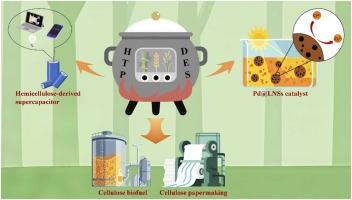Fabrication of hemicellulose-derived supercapacitor and Pd@lignin nanosphere catalyst by targeted lignocellulose fractionation
IF 6.2
1区 农林科学
Q1 AGRICULTURAL ENGINEERING
引用次数: 0
Abstract
Upgrading lignocellulose resources into value-added products is charming but encounters challenges due to their structural heterogeneity and product complexity. A tandem fractionation technique combining hydrothermal pretreatment (HTP) and deep eutectic solvent (DES) extraction was tailored to separate lignocellulosic three components selectively. HTP achieved almost 100 % hemicellulose dissolution into the aqueous stream, while subsequent DES extraction enabled efficient lignin removal (29–68 %) with high cellulose retention (>80 %). The water-soluble hemicellulose fraction was converted into activated nanocarbons (ANCs) via in-situ hydrothermal carbonization and KOH activation, yielding hierarchical porous materials with specific surface areas up to 2782 m² g⁻¹ . When applied in supercapacitors, rice straw-derived ANC exhibited a high specific capacitance of 284 F g⁻¹ at 0.5 A g⁻¹ and exceptional cycling stability (99 % retention after 10,000 cycles). Simultaneously, DES-extracted lignin riched in phenolic hydroxyl groups and condensed structure after tandem fractionation, was self-assembled into lignin nanospheres (LNSs) serving as supports for Pd nanoparticles (Pd@LNSs). The resulting catalyst demonstrated outstanding catalytic activity for toxic Cr (VI) reduction to Cr (III) under solar irradiation, achieving complete conversion within 8 min and maintaining > 90 % efficiency over eight cycles. This work establishes a closed-loop pathway for lignocellulose valorization, transforming underutilized hemicellulose and lignin into high-performance energy storage materials and robust catalysts, thereby enhancing the economic viability of biorefineries.

木质纤维素定向分馏制备半纤维素超级电容器及Pd@lignin纳米球催化剂
将木质纤维素资源转化为增值产品是很有吸引力的,但由于其结构的异质性和产品的复杂性,面临着挑战。采用水热预处理(HTP)和深度共熔溶剂萃取(DES)相结合的串联分馏技术对木质纤维素三组分进行了选择性分离。HTP在水流中实现了几乎100% %的半纤维素溶解,而随后的DES萃取使木质素的高效去除(29-68 %)和高纤维素保留率(>80 %)。水溶性半纤维素通过原位水热碳化和KOH活化转化为活性纳米碳(ANCs),得到比表面积高达2782 m²g(⁻¹ )的分级多孔材料。当应用于超级电容器时,稻秆来源的ANC表现出284 F g⁻¹ (0.5 a g⁻¹ )的高比电容和出色的循环稳定性(10,000次循环后保持99% %)。同时,des提取的木质素经串联分离后富含酚羟基和缩合结构,自组装成木质素纳米球(LNSs),作为Pd纳米颗粒的载体(Pd@LNSs)。所得到的催化剂在太阳照射下对有毒Cr (VI)还原为Cr (III)表现出出色的催化活性,在8 min内实现完全转化,并在8个循环中保持>; 90 %的效率。这项工作建立了木质纤维素增值的闭环途径,将未充分利用的半纤维素和木质素转化为高性能的储能材料和强大的催化剂,从而提高了生物精炼厂的经济可行性。
本文章由计算机程序翻译,如有差异,请以英文原文为准。
求助全文
约1分钟内获得全文
求助全文
来源期刊

Industrial Crops and Products
农林科学-农业工程
CiteScore
9.50
自引率
8.50%
发文量
1518
审稿时长
43 days
期刊介绍:
Industrial Crops and Products is an International Journal publishing academic and industrial research on industrial (defined as non-food/non-feed) crops and products. Papers concern both crop-oriented and bio-based materials from crops-oriented research, and should be of interest to an international audience, hypothesis driven, and where comparisons are made statistics performed.
 求助内容:
求助内容: 应助结果提醒方式:
应助结果提醒方式:


